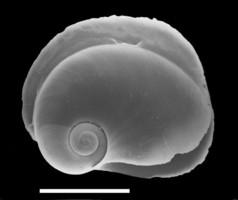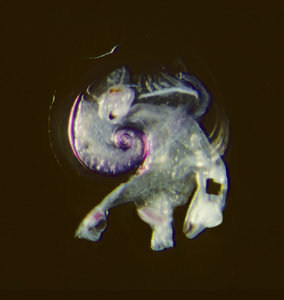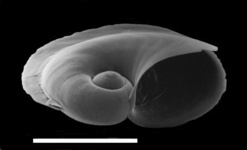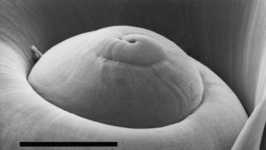Atlanta oligogyra
Roger R. SeapyIntroduction
Atlanta oligogyra is a moderately small species (maximal shell diameter of 2.1 mm in the Pacific and 2.8 mm in the Atlantic and Indian Oceans). The shell is transparent, with relatively thick and strong walls. The spire is light violet, compact and low, with a smooth surface, and consisting of about 2-1/2 whorls. In tilted or oblique views, the shape of the spire is low and rounded. The sutures between the first and second spire whorls are shallow, giving the spire a dome-like appearance. The keel is moderately elevated, with a rounded leading edge and a clear to brown base. Eyes type a. Operculum type b. Radula type I, small and ribbon-like. Geographic distribution is cosmopolitan in tropical to subtropical waters. In Hawaiian waters A. oligoyra is limited to the upper 150 m of the water column, with most individuals in the upper 100 m and some evidence for nocturnal vertical migration from 50-100 m during the day into the upper 50 m at night.
Diagnosis
- Maximal shell diameter = 2.1 mm (Pacific Ocean) and 2.8 mm (Atlantic and Indian Oceans)
- Shell transparent with relatively thick, strong walls
- Spire small and low, with a smooth surface and a rounded profile
- Spire consists of about 2-1/2 whorls
- Spire sutures between first and second whorls shallow, giving spire a dome-like appearance
- Keel moderately tall, with rounded leading edge and a clear to brown base
- Eyes type a
- Operculum type b
- Radula type I, small and ribbon-like
Characteristics
- Shell
- Maximal shell size mostly less than 3 mm: greater in the Atlantic (2.8 mm; Richter, 1986) and Indian (3.1 mm; Richter, 1974) Oceans than in the Pacific Ocean off eastern Australia (2.1 mm; Newman, 1990) and Hawaii (2.0 mm; Seapy, 1990a,b)
- Shell with relatively thick and strong walls (Richter, 1986)
- Keel moderately tall, with a rounded leading edge (see first SEM below)
- Spire consists of about 2-1/2 whorls
- Spire shape low, rounded (see fourth SEM below)
- Spire sutures between first and second whorls shallow, thus giving the spire a smooth, dome-like appearance when viewed from the side (see fourth SEM below); sutures between second and third and between third and fourth whorls deep, with the result that whorls subsequent to the second one are easily distinguished from each other
 Click on an image to view larger version & data in a new window
Click on an image to view larger version & data in a new window

 Click on an image to view larger version & data in a new window
Click on an image to view larger version & data in a new windowFigure. Scanning electron micrographs of a 1.1 mm Atlanta oligogyra. Shell viewed from right side (above left), and at about a 60° tilt (below left). Spire viewed from right side (above right) and at about a 60° tilt (below right). Scale bars = 0. 5 mm (left) and 0.1 mm (right). ©
- Coloration
- Shell spire light violet in waters off Hawaii (see title illustration) and off eastern Australia (Newman, 1990). Richter (1974) described the spire color in Indian Ocean specimens as red-violet. In his 1986 paper, Richter noted that in live or recently preserved animals, the shell has a weak rose color
- Keel base brown in shells from the Indian and Atlantic Oceans (Richter, 1974, 1986), although in Hawaiian waters, the keel base in juvenile and small adults is clear (Seapy, 1990a)
- Shell spire light violet in waters off Hawaii (see title illustration) and off eastern Australia (Newman, 1990). Richter (1974) described the spire color in Indian Ocean specimens as red-violet. In his 1986 paper, Richter noted that in live or recently preserved animals, the shell has a weak rose color
- Eyes type a
- In contrast with the proportionately large lens of A. lesueurii (Richter, 1986), the lens of A. oligogyra is comparable in size to those of other species in the genus
- In contrast with the proportionately large lens of A. lesueurii (Richter, 1986), the lens of A. oligogyra is comparable in size to those of other species in the genus
- Operculum type b
- Radula type I
- Radula small; long and narrow (Richter, 1986, fig. 6)
- Lateral teeth monocuspid or with a very small accessory cusp (Richter, 1986, fig. 15)
Comments
Atlanta oligogyra is very similar in general appearance to A. lesueurii. Although Tesch (1908) recognized both species as valid, in his 1949 monograph on the Heteropoda of the Dana Expedition he made A. oligogyra a junior synonym of A. lesueurii. Subsequently, van der Spoel (1976) also rejected A. oligogyra as a valid species. In his Meteor Expedition report on the Heteropoda of the Indian Ocean, however, Richter (1974) resurrected A. oligogyra as a valid species, describing clear differences between it and A. lesueurii. He subsequently (1986) published a paper presenting a direct comparison of the two species.
As described in Richter (1974, 1986), Seapy (1990a) and Richter and Seapy (1999), A. oligogyra is distinguished from A. lesueurii by several characteristics. First, and most distinctively, the eyes of A. oligogyra are type a (lacking a transverse slit in the distal pigmented tissue) and the lens is of average size, while the eyes of A. lesueurii are type b (possessing a transverse slit in the distal pigmented tissue) and the lens is large in relation to the basal portion of the eye. Second, although both species have small spires, that of A. oligoygra is low and dome-shaped with a shallow suture between the first and second whorls, while that of A. lesueurii is only somewhat elevated with distinctive first and second whorls, caused by the deep suture between these two whorls. Third, the keel of A. oligogyra is moderately tall with a rounded leading edge, while that of A. lesueurii becomes very tall in adults with a truncate leading edge.
The relative abundance of Atlanta oligogyra among other atlantid species was examined from the northwestern Indian Ocean by Richter (1974) and from Hawaiian waters, North Pacific Ocean by Seapy (1990a,b and 2008). In the Indian Ocean study, it was abundant; ranking third of sixteen atlantid species and accounting for 9.2% of the total species count. But in the three Hawaiian studies its abundance was consistently low. In the 1990a paper it ranked eighth of thirteen species and represented 2.6% of the total species count. In the 1990b study it was recorded in low numbers, with maximal densities of 0.7 individuals per 1,000 m3 in 0-45 m nighttime tows. Lastly, in the 2008 paper it ranked seventh of ten species with a mean nighttime density of 1.2% of the total during a fall sampling period, while in a spring period it ranked ninth of fifteen species with a mean nighttime density of 0.5% of the total.
The diel vertical distribution of Atlanta oligogyra was studied in Hawaiian waters by Seapy (1990b, 2008). In the first study low numbers (less than 1 individual per 1,000 m3) were recorded from three depth intervals between the surface and 140 m. Limited evidence supported nocturnal vertical migration from 45-90 m during the day into the upper 45 m at night. In the second paper diel vertical distributions of atlantids were examined at 1, 5, and 15 nmi stations off leeward Oahu. The highest abundances (7-9 individuals per 1,000 m3) were recorded during the day in fall and spring sampling periods from 0-20 m at the 15 nmi station. The vertical range extended to a maximal depth of 70-80 m at the 1 nmi station, but most records were limited to the upper 40 m elsewhere. Due most probably to the paucity of data, there was no evidence supporting nocturnal vertical migration or onshore-offshore differences in abundance.
References
Newman, L. J. 1990. Holoplanktonic molluscs (Gastropoda: Thecosomata and Heteropoda) from the waters of Australia and Papua New Guinea: their taxonomy, distribution and biology. Ph.D. thesis. University of Queensland, Brisbane, Australia.
Richter, G. 1974. Die Heteropoden der "Meteor"-Expedition in den Indischen Ozean, 1964/65. "Meteor" Forschungs-Ergebnisse (D) 17: 55-78.
Richter, G. 1986. Zur Kenntnis der Gattung Atlanta (II). Atlanta lesueuri Souleyet und Atlanta oligogyra Tesch (Prosobranchia: Heteropoda). Archiv für Molluskenkunde 117: 19-31.
Richter, G. and R. R. Seapy. 1999. Heteropoda, pp. 621-647. In: D. Boltovskoy (ed.), South Atlantic Zooplankton. Backhuys Publishers, Leiden.
Seapy, R. R. 1990a. The pelagic family Atlantidae (Gastropoda, Heteropoda) from Hawaiian waters: a faunistic survey. Malacologia 32(1): 107-130.
Seapy, R. R. 1990b. Patterns of vertical distribution in epipelagic heteropod molluscs off Hawaii. Marine Ecology Progress Series 60: 235-246.
Seapy, R. R. 2008. Offshore-onshore and vertical distributional patterns of heteropod mollusks off leeward Oahu, Hawaii. Marine Biology 154: 985-995.
Spoel, S. van der. 1976. Pseudothecosomata, Gymnosomata and Heteropoda (Gastropoda). Bohn, Scheltema and Holkema, Utrecht. 484 pp.
Tesch, J. J. 1908. Systematic monograph of the Atlantidae (Heteropoda) with enumeration of the species in the Leyden Museum. Notes from the Leyden Museum 30: 1-30, 5 plates.
Tesch, J. J. 1949. Heteropoda. Dana Report 34, 53 pp., 5 plates.
Title Illustrations

| Scientific Name | Atlanta oligogyra |
|---|---|
| Location | Hawaiian waters |
| Comments | Unexplained white inclusion present in photograph, located immediately distal to the eyes and covering the left tentacle and part of the proboscis |
| Specimen Condition | Live Specimen |
| Sex | Male |
| Life Cycle Stage | adult |
| View | right side |
| Size | shell diameter = 1.8 mm |
| Image Use |
 This media file is licensed under the Creative Commons Attribution-NonCommercial License - Version 3.0. This media file is licensed under the Creative Commons Attribution-NonCommercial License - Version 3.0.
|
| Copyright |
©

|
About This Page

California State University, Fullerton, California, USA
Correspondence regarding this page should be directed to Roger R. Seapy at
Page copyright © 2011
 Page: Tree of Life
Atlanta oligogyra .
Authored by
Roger R. Seapy.
The TEXT of this page is licensed under the
Creative Commons Attribution License - Version 3.0. Note that images and other media
featured on this page are each governed by their own license, and they may or may not be available
for reuse. Click on an image or a media link to access the media data window, which provides the
relevant licensing information. For the general terms and conditions of ToL material reuse and
redistribution, please see the Tree of Life Copyright
Policies.
Page: Tree of Life
Atlanta oligogyra .
Authored by
Roger R. Seapy.
The TEXT of this page is licensed under the
Creative Commons Attribution License - Version 3.0. Note that images and other media
featured on this page are each governed by their own license, and they may or may not be available
for reuse. Click on an image or a media link to access the media data window, which provides the
relevant licensing information. For the general terms and conditions of ToL material reuse and
redistribution, please see the Tree of Life Copyright
Policies.
- First online 30 October 2009
- Content changed 23 July 2011
Citing this page:
Seapy, Roger R. 2011. Atlanta oligogyra . Version 23 July 2011. http://tolweb.org/Atlanta_oligogyra/28767/2011.07.23 in The Tree of Life Web Project, http://tolweb.org/











 Go to quick links
Go to quick search
Go to navigation for this section of the ToL site
Go to detailed links for the ToL site
Go to quick links
Go to quick search
Go to navigation for this section of the ToL site
Go to detailed links for the ToL site